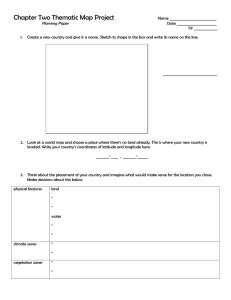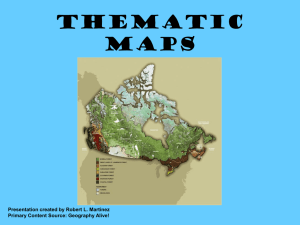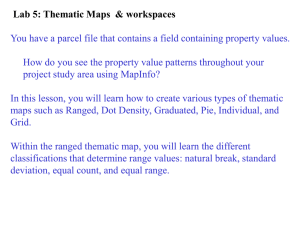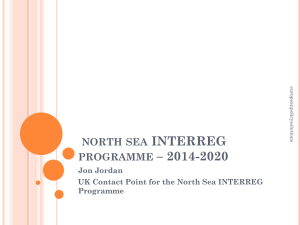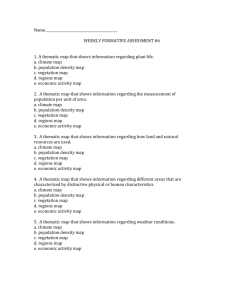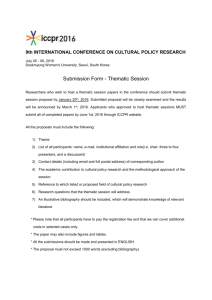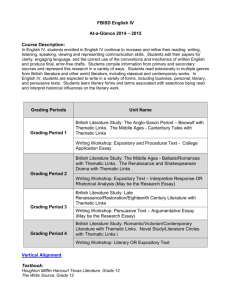Strategic Conservation Plan Outline, November 2010
advertisement
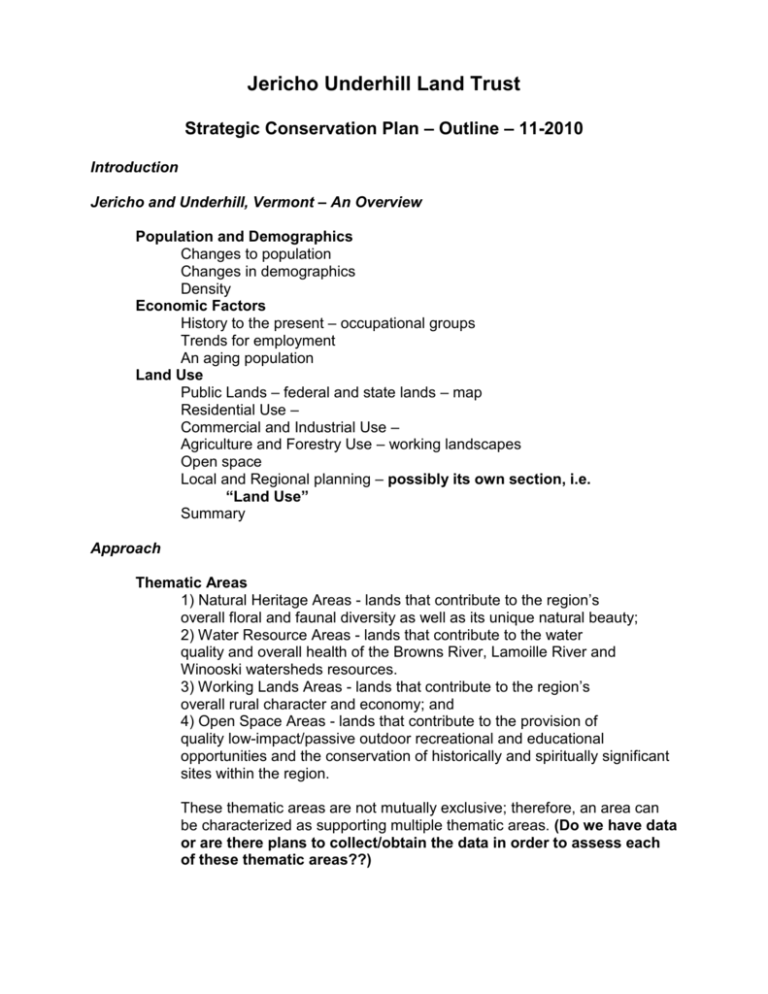
Jericho Underhill Land Trust Strategic Conservation Plan – Outline – 11-2010 Introduction Jericho and Underhill, Vermont – An Overview Population and Demographics Changes to population Changes in demographics Density Economic Factors History to the present – occupational groups Trends for employment An aging population Land Use Public Lands – federal and state lands – map Residential Use – Commercial and Industrial Use – Agriculture and Forestry Use – working landscapes Open space Local and Regional planning – possibly its own section, i.e. “Land Use” Summary Approach Thematic Areas 1) Natural Heritage Areas - lands that contribute to the region’s overall floral and faunal diversity as well as its unique natural beauty; 2) Water Resource Areas - lands that contribute to the water quality and overall health of the Browns River, Lamoille River and Winooski watersheds resources. 3) Working Lands Areas - lands that contribute to the region’s overall rural character and economy; and 4) Open Space Areas - lands that contribute to the provision of quality low-impact/passive outdoor recreational and educational opportunities and the conservation of historically and spiritually significant sites within the region. These thematic areas are not mutually exclusive; therefore, an area can be characterized as supporting multiple thematic areas. (Do we have data or are there plans to collect/obtain the data in order to assess each of these thematic areas??) Criteria Thematic area specific and overall criteria are identified (Table “x”). Criteria are to be used to identify areas of high conservation significance. Contributing factors are to be developed to measure each of the criteria. Key Data Sets Criteria and their contributing factors will guide the procurement of data regarding the resources of the Jericho Underhill area associated with the four thematic areas. Datasets will be obtained from a variety of sources, including but not limited to, CCRPC, VT ANR, VCGI, WNRCD, USFW, UCC, and JCC. Pertinent information will be extracted from these datasets resulting in “x” Data Layers (Table “x”) and more fully described in Appendix “x”. Geographic Information System (GIS) Analysis Once all of the Key Data Layers are obtained and/or developed, analysis of the data using GIS will begin. Two different analytical approaches, an overlay and a scored analysis, will be used to identify areas of high conservation significance. Overlay Analysis The Overlay Analysis will be the initial analysis performed on the data. To begin with, a base map for each Thematic Area will be created using the Key Data Layer datasets. These base maps visually demonstrate where overlap is occurring between the Key Data Layer datasets (Maps “x” – “z”). Based on the assumption that areas exhibiting conservation significance for multiple Thematic Areas are of higher priority, the next step will be to overlay the three Thematic Base Maps to create a final combined analysis. To accomplish this portion of the analysis, the following steps will be taken: 1. The final single layer maps for each Thematic Area will be overlaid onto one another; 2. A series of intersections will be conducted to identify areas where two Thematic Areas overlap, 3. The layer illustrating the intersection of Water Resources and Working Lands will be clipped to the Natural Heritage base layer to identify areas where all three Thematic Areas overlap. When classifying the areas into three levels of priority, it does not matter how many Key Data Layers overlap and the two Overall Criteria – Connectivity and Unique Values – are not considered. Areas meeting criteria for one Thematic Area will be classified as Low. Areas demonstrating an overlap between two Thematic Areas will be classified as Medium and areas that meet criteria for all three Thematic Areas will be classified as High (Map “x”). 2 Scored Analysis To fully account for all contributing factors defining each criterion for each Thematic Area, a Scored Analysis will be performed on the data. For this analysis, two underlying assumptions are made: 1. Key data layers deemed more important to an area’s conservation significance will be assigned a higher point value; and 2. All Thematic Areas are of equal importance. The first step of this analysis will be the creation of a scoring system which involves each of the Key Data Layers being assigned a point value. As each of the Thematic Areas is to be of equal importance, a multiplier will be used to ensure that the total possible score for each Thematic Area is 100. Hence, each Key Data Layer will have a point value that is multiplied by the appropriate multiplier to yield a weighted value (Appendix “x”). Unlike the Overlay Analysis this analysis will account for the Overall Criteria of Connectivity and Unique Values. These will be assigned a point value; however, they will not be weighted as they only contribute to the combined score and not the individual Thematic Area Scores (Appendix “x”). Once the scoring system is developed and applied to each of the Key Data Layers, GIS will be used to combine all of the layers together using a series of unions for each of the Thematic Areas. By using unions to join the layers together, new polygons will be created where overlap occurs between the data sets. A raw score will be calculated for each polygon within a Thematic Area by adding up the total points received. This raw score will then be multiplied by the appropriate multiplier to yield a total weighted score for each polygon within a Thematic Area. These scores will then be classified using natural breaks in the score values into four priority levels -- Low, Medium Low, Medium, and High (Maps “x” – “z” and Table “x”). Table X. Priority Level Scores for each Thematic Area. Priority Level Natural Heritage Working Lands Water Resources High Medium Medium Low Low Once each Thematic Area has been evaluated, they are combined together using unions and a final weighted score will be calculated that adds all three Thematic Area weighted scores together and groups them 3 into the four priority level classes using natural breaks in the score values (Map “x”). The final stage of this analysis involves the addition of the Overall Criteria Key Data Layers for Connectivity and Unique Values to the Scored Analysis Map using a series of unions. A final score will then be calculated for each polygon in this Final Scored Analysis layer which will then be grouped using natural breaks in the score values into the four priority levels (Map “x” and Table “x”). Table X. Priority Level Scores for Overall Conservation Significance. Priority Level Low Medium Low Medium Low Overall Conservation Significance Score Range Partners Peer Review An important final step to be taken in the development of this Strategic Conservation Plan is feedback from partner organizations and natural resource professionals familiar with Jericho and Underhill’s natural resources. JULT Board members will create a list of peer reviewers (Appendix “x”). Reviewers would be met with in person and solicited for their feedback on the methodology, priority area descriptions, pertinent maps, and initial recommended strategies. All reviewers will be asked to provide feedback on the following items based on their professional and personal knowledge of Jericho / Underhill region: 1. The validity of the proposed Priority Conservation Areas and their relative significance level; 2. The type and level of threat faced by each Priority Conservation Area; and 3. The identification of appropriate conservation strategies including potential partners and funding sources to recommend for each Priority Conservation Area. Once received, the feedback will be compiled and incorporated into the final Strategic Conservation Plan as appropriate. Priority Conservation Areas A B C D E 4 F G Etc Conservation Strategies Conclusion References Appendices Land Use Data Key Data Layers Scoring System Maps Tables 5 Potential Data Sets Vermont Significant Wetland Inventory – 2009, ANR Agriculturally Important Soils – USDA SSURGO Biological Hotspots – 2000, VT Fish & Wildlife Rare, Threatened, Endangered Species & Natural Communities – 2006, NNHP Deer Wintering Areas – 1996, ANR Parcels – Towns or VCGI Roads Large Habitat Block Wildlife Corridors / Road Crossings / Habitat Suitability Waterbodies Conserved Lands – Land Trusts / Local / State / Federal Ortho – multiple sources Land Use / Land Cover – VCGI, ANR VAST 6 Table “x”. Overall and Specific Thematic Area Criteria and Contributing Factors Thematic Criteria Contributing Factors Number Key Area of Key Data Data Layer Layers s Natural Heritage High Quality Terrestrial Habitats Water Resources High Water Quality Water Resources High Quality Aquatic Habitats Working Lands Lands highly suitable for retention as working lands (agriculture, forestry) Areas containing terrestrial species and/or natural communities as defined by the Natural Heritage Information Project. Areas identified in a conservation plan as important habitat for terrestrial species. Waterways of outstanding or excellent quality. Reference reaches of waterways. Area identified in a conservation plan as important for the protection of water quality. Cold water streams supporting natural populations of trout. Areas identified as important for fish spawning. Areas containing aquatic species and/or natural communities as defined by the Natural Heritage Information Project. Areas identified in a conservation plan as important habitat for aquatic species. Those aquatic locations, such as vernal pools, not classified as wetlands. Areas containing prime or statewide important soils, which do not require draining, as defined by NRCS. Areas zoned for agriculture or forestry use. Areas located within floodplain or ???ft of perennial rivers. Open Space Overall Connectivity Overall Unique Values Areas within ??mile to sites already protected for public benefit. Areas within ??mile of sites protected under various conservation programs. Areas identified as unique natural or geologic features. Areas identified for scenic values. Areas indentified as historically or spiritually significant. Areas identified in Jericho’s and Underhill’s Town Plans. 7
